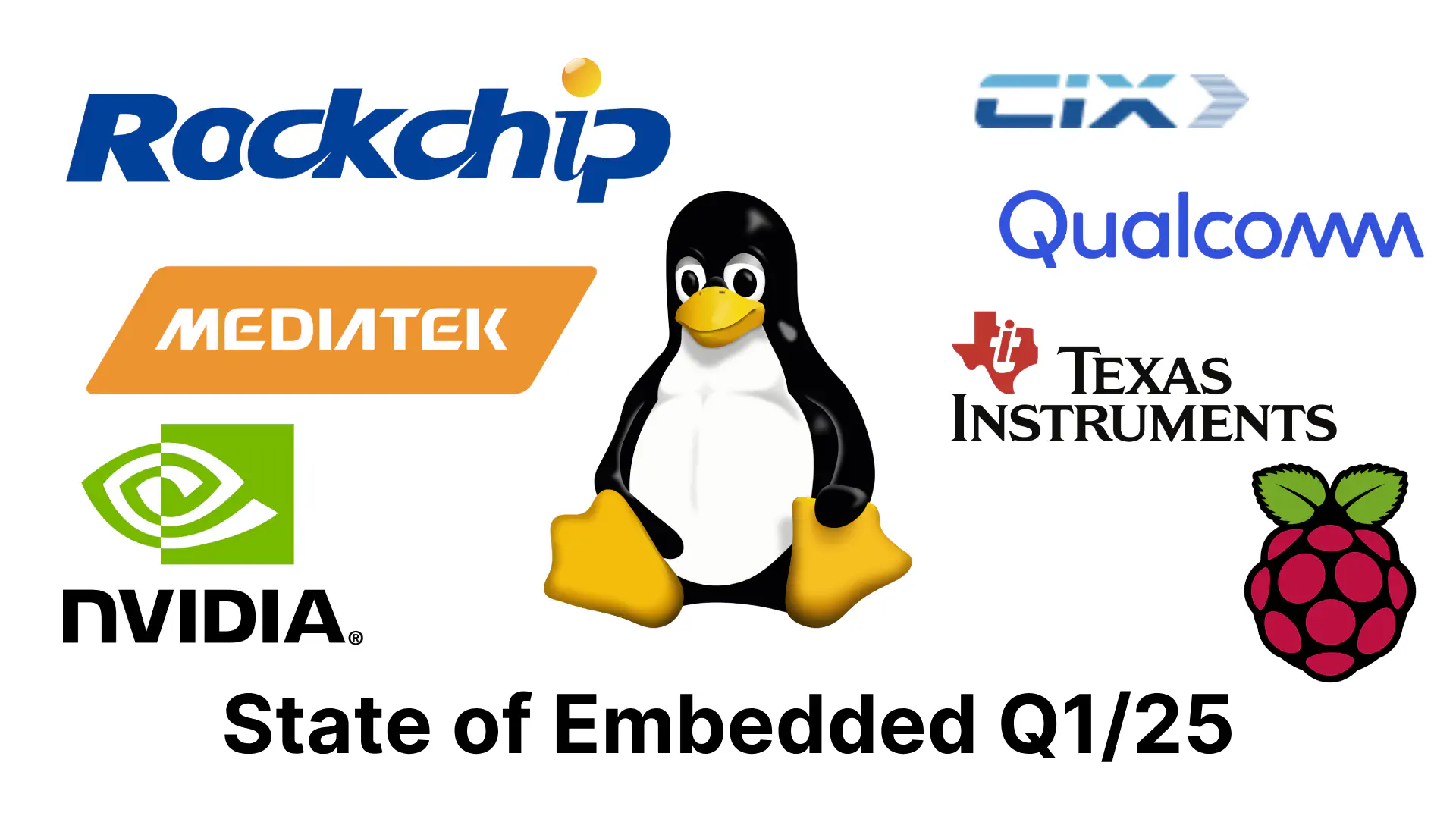State of Embedded: Q1 2025 Overview
Estimated reading time: 5 minutes

State of Embedded: Q1 2025 Overview #
In this quarterly update, we explore recent developments in the embedded Single Board Computer (SBC) market, highlighting notable advancements in ARM-based Systems-on-Chip (SoCs) and their increasing competitiveness against traditional x86 platforms. We review the major achievements and near-future expectations from key industry vendors.
CIX #
Flagship SoC: CD8180 / P1
Notable Product: Radxa Orion-O6
Price: Starting at ~$200
The newcomer CIX had its first SoC recently released in the Radxa Orion-O6. The CD8180/P1 is a Desktop class CPU with 12 cores (8x A720 4x A520). Early Linux software support has proven promising, with Linux kernel 6.14 successfully running desktop environments via ACPI and BSP kernel using device-tree boot. Efforts for mainline kernel integration have begun, including an initial patch submission. But you still have to keep in mind that like with all new SoC’s coming to market it will take months (realistically years) until all drivers are fully upstreamed. A key highlight of Orion-O6 is its full-sized PCIe Gen4 slot (electrically x8), enabling extensive application opportunities at an attractive price point. Additionally, GPU support for Mali G720 is progressing rapidly, with Mesa Panfrost integration underway (merge request here). Combined with the rapid development of the Panthor Kernel Driver and PanVK, CIX’ product has quickly garnered our interest as a contender for an affordable ARM desktop.
Rockchip #
Flagship SoC: RK3588
Rockchip continues to deliver high-performance hardware, drawing significant attention from the open-source community. Although internal support for open-source software remains inconsistent, external efforts like those from Collabora continue to improve hardware enablement for the RK3588 and RK3576 SoCs.
The company’s BSP kernel is actively advancing, reaching version 6.1.115, a considerable improvement over previous releases since this is now available on Rockchip’s own GitHub Repo. While vendor built images often lag behind, community projects such as Armbian maintain close alignment with recent BSP updates.
Rockchip has for example introduced usability improvements, such as video processing unit (VPU) metrics, though software licensing issues persist—evidenced by ongoing LGPL violations from upstream FFmpeg in MPP.
Open-source efforts:
- Mainline Linux 6.15 adds HDMI sound output which has been a long awaited feature.
- Upstream Jellyfin with hardware acceleration has proven stable on RK3588, making it attractive for home-lab setups.
- Active PanVK Vulkan development is happening on RK3588’s Mali G610, currently supporting Vulkan 1.1.
Future developments include the anticipated RK3688, though concrete details remain undisclosed.
MediaTek #
Flagship SoC: Genio-1200 (MT8395)
Notable Product: Radxa Nio-12L
MediaTek has been quickly closing the gap with other ARM vendors, as demonstrated by their Genio-1200 SoC powering the Radxa Nio-12L. This board, introduced at Embedded World 2024, surpasses Rockchip’s RK3588 in CPU performance (thanks to the use of ARM Cortex-A78 cores instead of Cortex-A76) but falls behind in GPU capability due to its older Mali Valhall V9 G-57 GPU for which PanVK is uncertain as that is targeting Valhall V10 and newer.
A significant turning point came in November 2024, when Collabora announced a partnership, greatly enhancing Linux support. Today, MediaTek development kits and boards such as the Nio-12L can run Debian Trixie and Armbian using mainline kernels, marking considerable progress beyond the original limited BSP.
However, developer tooling remains behind competitors, largely due to reliance on software initially developed for Android smartphones.
On the Chromebook SoC front, MediaTek unveiled the MT8196 (Kompanio Ultra), based on the Dimensity 9400 chipset. This ARMv9 chipset presents a strong competitor to CIX’s CD8180/P1, though its adoption in embedded applications or mini-PC form remains speculative.
Nvidia #
Nvidia has generated attention through notable price reductions and strategic partnerships. Most prominently, the Orin Nano Super Development Kit dropped in price from $499 to $249, a welcome change driven by the growing AI market.
Additionally, Nvidia’s collaboration with MediaTek resulted in the GB10 Grace Blackwell Superchip, which powers the newly announced DGX Spark ($3999). Outside AI-specific applications, the GB10 chipset has sparked interest due to its potential role in upcoming MediaTek-powered Windows-on-ARM devices, which could significantly lower costs for powerful ARM-based PCs.
Qualcomm #
Flagship SoC: Snapdragon Oryon
Qualcomm’s Snapdragon Oryon processors are now widely available in laptops, with many offering basic Linux support via device-tree. However, Qualcomm’s efforts remain limited, notably due to the indefinite cancellation of its anticipated developer kit. Likewise, the Geekom QS1 Pro based on Oryon which has been announced in December 2024, remains unavailable.
Rumors persist about a Snapdragon X2 featuring 18 Oryon V3 cores, but there are no confirmed details or timelines available.
Texas Instruments #
Flagship SoCs: AM68, AM69
Texas Instruments (TI) operates quietly but consistently in the embedded space, prioritizing robust software support and upstream kernel integration. TI distinguishes itself by using proprietary IP alongside Imagination’s GPU solutions rather than the more common ARM Mali GPUs found in competitors’ products.
Mainline kernel support:
- Actively developed, though certain features remain incomplete.
- GPU support status (Imagination BXS-4-64): Currently non-conformant Vulkan 1.0.
TI actively collaborates with open-source projects like Armbian, facilitating the availability of Debian and Ubuntu-based user environments. No new SoCs have been announced in the current timeline.
Other Vendors #
- NXP: Limited consumer-focused developments currently. Notably, YouTuber Tomaž Zaman will soon release an open-source focused Router based on a NXP Layerscape SoC.
- Broadcom / Raspberry Pi: No significant updates beyond existing Pi 5 developments.
Conclusion #
In Q1 2025, the embedded SBC market saw meaningful advancements from CIX, whose accessible and powerful CD8180/P1 platform generated significant interest. MediaTek demonstrated rapid improvement in Linux support, while Rockchip and Nvidia maintained steady progress in hardware capability. Qualcomm’s involvement remains subdued, and Texas Instruments continues its steady, open-source-friendly trajectory.
Overall, the SBC ecosystem remains dynamic and competitive, with increasing emphasis on open-source integration and broader Linux support, setting an optimistic outlook for the remainder of 2025.